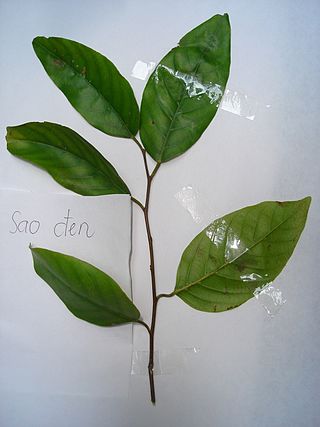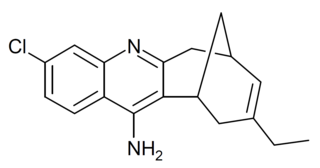
Huperzine A is a naturally occurring sesquiterpene alkaloid compound found in the firmoss Huperzia serrata and in varying quantities in other food Huperzia species, including H. elmeri, H. carinat, and H. aqualupian. Huperzine A has been investigated as a treatment for neurological conditions such as Alzheimer's disease, but a meta-analysis of those studies concluded that they were of poor methodological quality and the findings should be interpreted with caution. Huperzine A inhibits the breakdown of the neurotransmitter acetylcholine by the enzyme acetylcholinesterase. It is commonly available over the counter as a nutrient supplement, and is marketed as a cognitive enhancer for improving memory and concentration.

The Hainan gymnure or Hainan moonrat is a species of mammal in the family Erinaceidae. Its natural habitat is subtropical or tropical dry forests. It was thought to be endemic to the island of Hainan, China where it is threatened due to habitat loss, but in 2018 was found to also occur in, and be rather common, within Northern Vietnam.

Hopea is a genus of plants in the family Dipterocarpaceae. It contains some 113 species, distributed from Sri Lanka and southern India to the Andaman Islands, Myanmar, southern China, and southward throughout Malesia to New Guinea. They are mainly main and subcanopy trees of lowland rainforest, but some species can become also emergent trees, such as Hopea nutans.
Hopea aptera is a species of plant in the family Dipterocarpaceae. It is endemic to Papua New Guinea. The tree is harvested from the wild for its timber, which is widely used within the tree's native range. The plant is classified as 'Data Deficient' in the IUCN Red List of Threatened Species.

Hopea beccariana is a species of tree in the family Dipterocarpaceae. It is named for the Italian botanist Odoardo Beccari.
Hopea chinensis is a species of medium-sized tree in the family Dipterocarpaceae. It is found in China and northern Vietnam.
Hopea glabrifolia is a species of plant in the family Dipterocarpaceae. It is endemic to Papua New Guinea.
Hopea malibato is a species of plant in the family Dipterocarpaceae. It is endemic to the Philippines.

Hopea odorata, or ta-khian, is a species of plant in the family Dipterocarpaceae. It is found in Bangladesh, Cambodia, India, Laos, Malaysia, Myanmar, Thailand, and Vietnam. It is a large tree reaching up to 45 m in height with the base of the trunk reaching a diameter of 4.5 m. It grows in forests, preferably near rivers, at altitudes between 0 and 600m. In places such as West Bengal and the Andaman Islands it is often planted as a shade tree. Valued for its wood, it is a threatened species in its natural habitat.

Hopea parviflora is a species of plant in the family Dipterocarpaceae. It is endemic to India. It is called 'kampakam' or 'thampakam' in Malayalam and கோங்கு 'vellaikongu' or 'irubogam' in Tamil. Hopea parviflora is a tree growing 30 – 37 metres tall. The bole can be 150 cm in diameter. The tree produces a beautiful timber and is commonly harvested from the wild, both for local use and for trade. The plant is classified as 'Least Concern' in the IUCN Red List of Threatened Species.
Hopea sangal is a tree in the family Dipterocarpaceae. It is native to tropical Asia.

Acetylcholinesterase (HGNC symbol ACHE; EC 3.1.1.7; systematic name acetylcholine acetylhydrolase), also known as AChE, AChase or acetylhydrolase, is the primary cholinesterase in the body. It is an enzyme that catalyzes the breakdown of acetylcholine and some other choline esters that function as neurotransmitters:

Acetylcholinesterase inhibitors (AChEIs) also often called cholinesterase inhibitors, inhibit the enzyme acetylcholinesterase from breaking down the neurotransmitter acetylcholine into choline and acetate, thereby increasing both the level and duration of action of acetylcholine in the central nervous system, autonomic ganglia and neuromuscular junctions, which are rich in acetylcholine receptors. Acetylcholinesterase inhibitors are one of two types of cholinesterase inhibitors; the other being butyryl-cholinesterase inhibitors. Acetylcholinesterase is the primary member of the cholinesterase enzyme family.

Cholinesterase inhibitors (ChEIs), also known as anti-cholinesterase, are chemicals that prevent the breakdown of the neurotransmitter acetylcholine or butyrylcholine. This increases the amount of the acetylcholine or butyrylcholine in the synaptic cleft that can bind to muscarinic receptors, nicotinic receptors and others. This group of inhibitors is divided into two subgroups, acetylcholinesterase inhibitors (AChEIs) and butyrylcholinesterase inhibitors (BChEIs).

Tabernaemontana divaricata, commonly called pinwheel flower, crape jasmine, East India rosebay, and Nero's crown, is an evergreen shrub or small tree native to South Asia, Southeast Asia and China. In zones where it is not hardy it is grown as a house/glasshouse plant for its attractive flowers and foliage. The stem exudes a milky latex when broken, whence comes the name milk flower

Methylfluorophosphonylcholine (MFPCh) is an extremely toxic chemical compound related to the G-series nerve agents. It is an extremely potent acetylcholinesterase inhibitor which is around 100 times more potent than sarin at inhibiting acetylcholinesterase in vitro, and around 10 times more potent in vivo, depending on route of administration and animal species tested. MFPCh is resistant to oxime reactivators, meaning the acetylcholinesterase inhibited by MFPCh can't be reactivated by cholinesterase reactivators. MFPCh also acts directly on the acetylcholine receptors. However, despite its high toxicity, methylfluorophosphonylcholine is a relatively unstable compound and degrades rapidly in storage, so it was not deemed suitable to be weaponised for military use.
BW284C51 is a selective acetylcholinesterase inhibitor. It is also a nicotinic antagonist.

TMTFA is an extremely potent acetylcholinesterase inhibitor. As a transition state analog of acetylcholinesterase, TMTFA is able to inhibit acetylcholinesterase at extremely low concentrations, making it one of the most potent acetylcholinesterase inhibitors known.

Huprine X is a synthetic cholinergic compound developed as a hybrid between the natural product Huperzine A and the synthetic drug tacrine. It is one of the most potent reversible inhibitors of acetylcholinesterase known, with a binding affinity of 0.026nM, as well as showing direct agonist activity at both nicotinic and muscarinic acetylcholine receptors. In animal studies it has nootropic and neuroprotective effects, and is used in research into Alzheimer's disease, and although huprine X itself has not been researched for medical use in humans, a large family of related derivatives have been developed.

Hopeahainol A is a polyphenol acetylcholinesterase inhibitor with the molecular formula C56H42O12. Hopeahainol A has been isolated from the tree Hopea hainanensis. Hopeahainol A may be used for the treatment of Alzheimer's disease.














